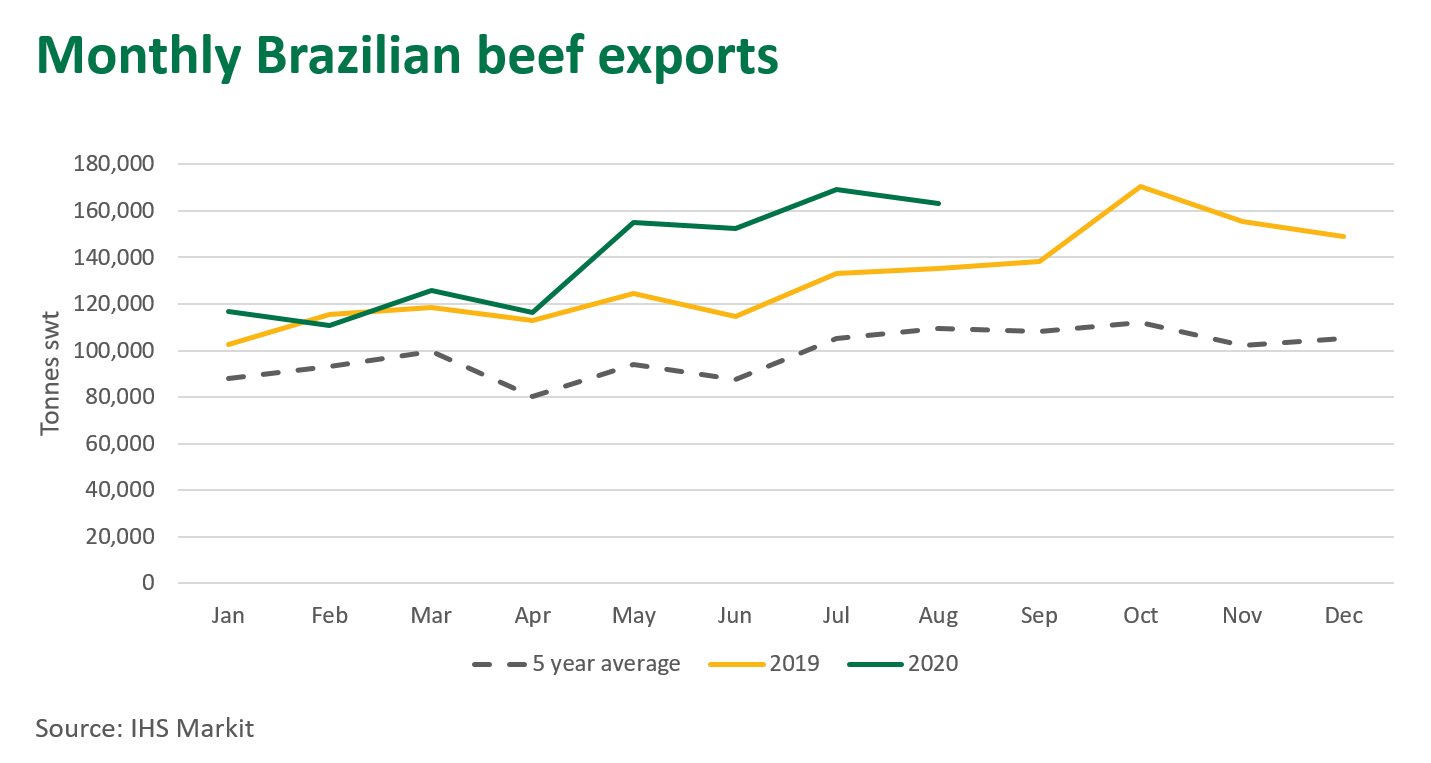Subscribe to The Weekly e-newsletter
For in-depth red meat market news, information and analysis.
Brazil moves ahead in global beef exports
24 September 2020
Key points:
- Brazilian beef exports supported by a favourable exchange rate and strong Chinese demand
- The Brazilian government is leading initiatives to support cattle productivity
- The Brazilian feedlot industry is predicted to double in size over the next five years
2020 has been a particularly turbulent year for global markets, with COVID-19 having a profound impact on the supply and demand for beef around the world. For Brazil, a softening exchange rate has resulted in higher domestic retail prices and a favourable export scenario, driving a greater proportion of Brazilian beef being directed into export markets than usual.
Brazilian beef exports booming
Despite the impact of COVID-19, Brazil is expected to reach a new global record for beef exports in 2020, largely attributed to strong demand in China due to the protein deficit caused by African Swine Fever (ASF) and the growing purchasing power of the Chinese middle class.
For Brazil, 2020 has been characterised by tighter cattle supplies and record beef export volumes. Cattle slaughter (federally inspected plants only) for the year-to-August is down 10% on 2019 levels, while beef exports have surpassed 1.1 million tonnes shipped weight tonnes (swt) for the same period, up 16% on last year.
USDA forecasts indicate that Brazilian beef exports for the year could surpass 2.5 million tonnes carcase weight equivalent (cwe), which would account for approximately 24% of global beef exports. Looking ahead to 2021, Brazilian beef exports are expected to lift a further 8% to reach 2.7 million tonnes cwe.
China continues to be the pivotal market for Brazil. For the year-to-August, 530,000 tonnes swt of beef has been shipped to China, up a staggering 145% on 2019 to account for 48% of all Brazilian beef exports. However, other major export markets have also increased their imports of Brazilian beef, including Saudi Arabia, the Philippines and Singapore.
Another key growth market for Brazil is the US, after regaining market access earlier in February following a pause in trade since 2017, when some shipments failed to meet USDA food safety standards. The US have now taken 10,000 tonnes swt for the year-to-date, mostly consisting of processed beef, with monthly shipments now at similar levels seen in 2017. Nevertheless, Brazil still faces challenges that will hinder rapid growth within the US market.

Beef production to lift in 2021
Due to reduced slaughter levels, cattle prices in Brazil have been stronger than historical levels, with producers now looking to bolster their cattle numbers coming into 2021. A number of production factors are fuelling optimism, particularly stable feed costs. In 2021, the USDA predict Brazilian beef production to be 10.5 million tonnes carcase weight (cwt), an increase of 4.1% on 2020.
A number of government programs (estimated at US$1.1 billion in value) are supporting cattle productivity gains, such as subsidies for pasture improvement, crossbreeding programs using imported cattle genetics, the acquisition of high quality seed stock and the increasing use of reproductive technologies. As a result of these programs, carcase weights have been improving.
Feedlot production systems set to expand
Beef production is expected to increase off the back of growth from both grass-fed systems and feedlot operations. While feedlots currently only account for approximately 10% of Brazil’s meat production, this is expected to double over the next five years. This shift in production focus could soon see Brazil challenge Australia and the US in grainfed beef export markets.
Usage of Angus genetics becoming more widespread
Brazilian livestock operations are increasingly using an ‘industrial cross’ of local Nelore cattle with US/Argentine Angus genetics. This industrial cross combines the feed efficiency and meat quality benefits derived from Angus cattle with the heat and tick tolerance found in the Nelore breed.
To foster this growing need for increasing Angus genetics, imports of cattle semen from the US, a traditional supplier of semen to Brazil, have lifted 35% on 2019 levels for the year-to-June. The expectation exists that semen imports will continue to grow through 2021, particularly as Brazilian cattle prices continue to lift and as the Brazilian government continues to make funds available at subsidised rates.
However, it has been reported that there is currently little premium being paid for marbled beef from industrial cross cattle. This may be a demand issue, represented by a lack of high-end branding and access to premium markets. If Brazil was to develop export relationships creating incentives to produce quality marbled beef, greater production volumes could quickly materialise.
Economic factors complementing Brazil’s export competitiveness
Currently, the price of Australian cattle is at a significant premium over their Brazilian counterparts, impacting the price point of beef exports. Furthermore, the soft value of the Brazilian Real is supporting its export industry, allowing global importers to purchase at a more favourable price point.
The outlook for the recovery of Brazil’s economy in 2021 is relatively positive, with lower inflation, stable unemployment rates and improved levels of consumer purchasing power. In 2021, Brazil’s GDP is expected to grow by 3.5%, after a downturn of 5.4% in 2020. If Brazil’s economy is able to regain some momentum, this would support the recovery of the Brazilian Real, thereby re-directing some processor focus back towards the domestic market and potentially alleviating some of the competitive pressure within export markets.
Currently, much of the additional beef being exported by Brazil is being soaked up by the elevated ASF-fuelled demand from China. However, considering Brazil’s focus on productivity, their competitive presence within global markets will likely continue building.
© Meat & Livestock Australia Limited, 2020


